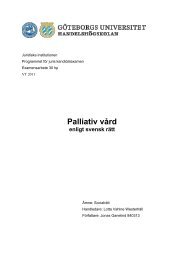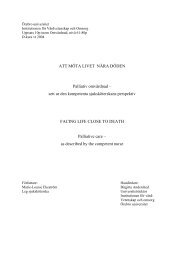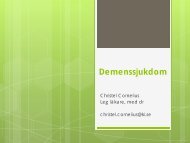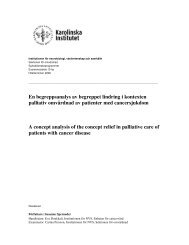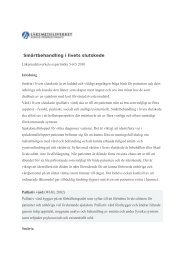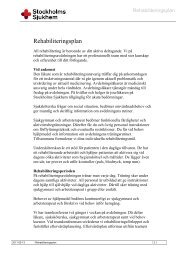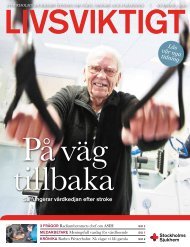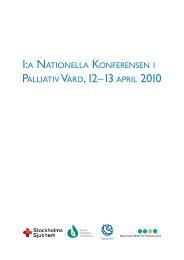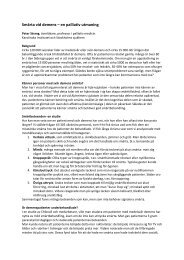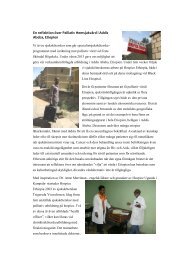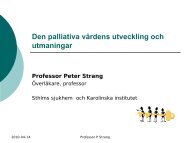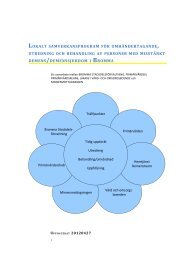Physiotherapy in palliative careâ - Stockholms sjukhem
Physiotherapy in palliative careâ - Stockholms sjukhem
Physiotherapy in palliative careâ - Stockholms sjukhem
Create successful ePaper yourself
Turn your PDF publications into a flip-book with our unique Google optimized e-Paper software.
Physical weaknessDecreased muscle strength and perseverance is common with patients who have an advancedchronic illness. The causes can be <strong>in</strong>activity due to other symptoms like fatigue, pa<strong>in</strong> anddyspnoea and aversion to eat<strong>in</strong>g which generate a lack of energy.Patients <strong>in</strong> an advanced stage of cancer often show a visible loss of muscle mass because of<strong>in</strong>creased prote<strong>in</strong> destruction and a decrease of the prote<strong>in</strong> synthesis <strong>in</strong> the skeleton muscles.Some medication like corticosteroids also give a loss of muscle mass, which is noticeableespecially <strong>in</strong> the quadriceps muscles. (7)To lose physical capacity is very stressful for most patients. Tiredness and worry make itdifficult to take the <strong>in</strong>itiative to take on activities and to move on their own. Many patients donot feel confident with their own body. How much are you allowed to do, is it acceptable topush yourself etc? The patient is afraid of putt<strong>in</strong>g too much burden on family and close friendswhen there is an <strong>in</strong>creas<strong>in</strong>g need of help as the body is fail<strong>in</strong>g.An important role as a physiotherapist is to support the patient to carry out activity or exerciseson his/her own. To do functional exercises, to be able to be <strong>in</strong>dependent <strong>in</strong> daily life, like forexample be able to go to the toilet on ones own, is valuable for the patient. Inspire the patient byshow<strong>in</strong>g the resources the patient has. See the possibilities!An improved physical status can give the patient a feel<strong>in</strong>g of be<strong>in</strong>g <strong>in</strong> control and improves selfrespect. Increased self esteem can result <strong>in</strong> better social relations and reduced fear and anxiety.(24)Assessment:Is the disease caus<strong>in</strong>g bodily restrictions, if yes of what k<strong>in</strong>d?How does the patient handle the everyday activities, mov<strong>in</strong>g, walk<strong>in</strong>g upstairs, manag<strong>in</strong>gthresholds etc?How much can the patient manage and what does the patient want to achieve by exercis<strong>in</strong>g?Treatment:Physical activity can be def<strong>in</strong>ed as all bodily movement produced by skeleton muscles andresult<strong>in</strong>g <strong>in</strong> an energy use. When physical activity is planned, structured and recurrent it iscalled physical exercise and is aimed at improv<strong>in</strong>g or ma<strong>in</strong>ta<strong>in</strong><strong>in</strong>g a special physical function.(18)<strong>Physiotherapy</strong> <strong>in</strong> <strong>palliative</strong> care – a cl<strong>in</strong>ical handbook Ulla Frymark, Lilian Hallgren, Ann‐Charlotte Reisberg 18



